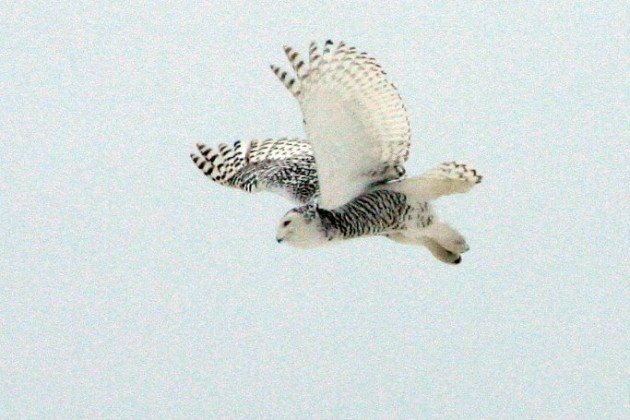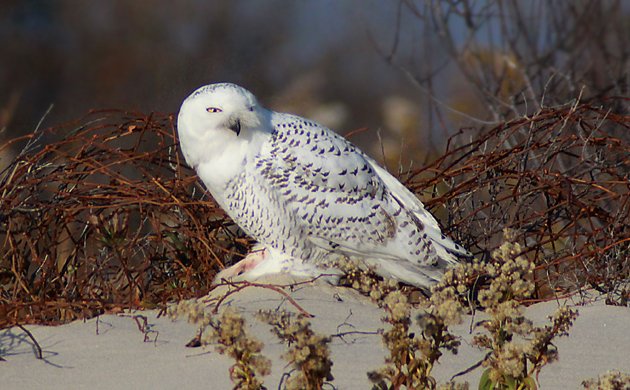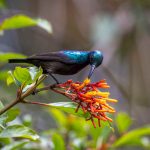
Over the past two weeks, an incursion of Snowy Owls (Bubo scandiacus) has spread rapidly across the Great Lakes region and down the Atlantic Coast, as far south as North Carolina. (The haunting image above is from another year, by Kate Ter Haar.)
It’s the third year in a row for a significant, hunger-driven push south by these spectacular predators of the far north, so commanding of the imagination with their striking plumage, remote origins, and wondrous peregrinations.
At first glance, they may seem to have little in common with other large owls, but it was 10 years ago this year when, in the 44th supplement to the AOU’s North American checklist, the Snowy Owl was removed from the monotypic genus Nyctea and subsumed into the genus Bubo with Great Horned Owl and the eagle-owls:
Former treatment of this species in the monotypic genus Nyctea was based on distinct plumage and weak osteological differences (Ford 1967). Genetic studies, however, indicate that it is closely related to Bubo (Sibley and Ahlquist 1990) and in fact is nested within the genus (Wink and Heidrich 1999). (Banks et al. 2003, PDF)
The Wink and Heidrich paper (Molecular systematics of Owls (Strigiformes) based on DNA sequences of mitochondrial cytochrome b gene, PDF), as the title indicates, looked at the mitochondrial cyt b gene across about a third of living owls and found Snowy Owl sister to Great Horned Owl, concluding, “the taxonomic consequences would be to merge Nyctea in Bubo….”
The results were confirmed, probably not surprisingly, in a similar 2002 study that added (and formally described for the first time) a boobook from Indonesia and on which Wink was a coauthor: A new Ninox owl from Sumba, Indonesia, PDF (Olsen et al. 2002).
Now, cyt b studies have proved potentially unreliable on their own — and sometimes even when combined with other datasets: after all, this was one of the methods used in the 1990s to further the ill-fated New World vultures-as-highly-modified-storks hypothesis — but none of the checklist authorities seem to have found any reason to question the conclusion that Snowy Owl is a Bubo.
In fact, in 2009, Wink et al. published a study that this time included nuclear DNA along with the mtDNA: Molecular phylogeny of owls (Strigiformes) inferred from DNA sequences of the mitochondrial cytochrome b and the nuclear RAG-1 gene. This new analysis again suggested that Snowy Owls (and the fascinating fish-owls) are embedded within the eagle-owl complex.
So I wasn’t aware there was any controversy about the matter, until I saw a passage in a new monograph on the bird, The Snowy Owl, by Eugene Potapov and Richard Sale. (Three hundred pages of Snowy Owl goodness for those who just can’t get enough.)
In recounting the bird’s taxonomic history in Chapter 3, the authors take a decidedly skeptical tone toward the move in the early 2000s to place the Snowy Owl into genus Bubo, criticizing the genetic studies and revealing a preference for highlighting the morphological differences between the eagle-owls and the Snowy Owl, at least some of which they admit are clearly adaptations for the Snowy Owl’s tundra lifestyle.
[T]he abundant morphological differences between Nyctea and Bubo (in the classic sense) indicate that the results of the cyt b-based phylogeny contradict the morphological data. In the absence of other data that would independently confirm the placement of Nyctea within Bubo we therefore prefer to maintain Nyctea as a separate genus within the Bubonini tribe. (Potapov and Sale 2013)
They go so far as to suggest that the Snowy Owl’s “[g]enetic similarity to the Great Horned Owl, which was suggested by Wink and Heidrich (1999 and 2000), could be a secondary event, or the result of parallelism.”
So to be clear, their point is not that Snowy Owls aren’t related to Bubo at all (clearly, they are), but whether they are in fact embedded within the genus as opposed to lying somewhere outside but nearby.
And this is a classic morphologist-vs.-systematist problem. Do you trust our ability to analyze the genes (which is still developing and thus prone to all sorts of shortcomings, including potential convergence), or do you trust our ability to analyze the morphology and imbue it with systematic meaning (which has tripped up brilliant scientists time and time again because the truth is often stranger that we can imagine)? We certainly do know from birds and other organisms that the most closely related organisms are not always the most similar physically, if one member of the pair has experienced strong adaptive pressure.
The authors’ musings will not cause any checklist committee angst; that would take publication of new scientific data, preferably a synthesis of several lines of evidence. We may learn more tomorrow, and that would be exciting.
In the meantime, those of us in eastern North America have another chance to observe (ethically and respectfully, of course) these powerful white tundra dinosaurs and contemplate their connection to the mighty brown forest-dwellers of our own latitudes, and all other life on our planet. And that’s a marvelous gift.
Snowy Owl, Queens, New York, 2013 © Corey Finger














Birds tend to be oversplit (like the barbets which are, what, five families now just to keep the toucans separate), so I’m happy with this being lumped. It doesn’t surprise me that a species in such an extreme environment might have rather more morphological variation.
Exactly. And I’m a bit baffled why these particular authors (who, certainly, have done a tremendous job with this monograph) would suggest that somehow the Snowy Owl must lie outside the clade rather than having evolved from within it, when the genetic data point toward the latter and the morphological data (presumably?) could be interpreted either way. Nothing is lost of the bird’s distinctiveness or majesty, surely, if that’s the concern.
Fascinating and very different look at the Snowy Owl. I had no idea that the genetic research dictating so many taxonomic changes these days are so fallible.